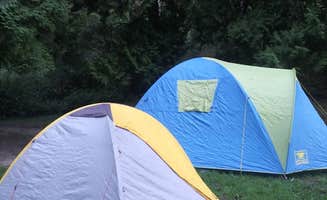Dispersed camping options in Wayne National Forest offer rustic experiences across various terrains within the 244,000-acre forest. The forest spans three distinct districts with elevations ranging from 650 to 1,250 feet. Primitive camping near Latham, Ohio typically requires self-sufficiency as most sites lack basic amenities and are accessible via unmaintained forest roads.
What to do
Fishing at forest ponds: Multiple fishing spots are available throughout the forest areas. Hanging Rock Recreation Area offers several small fishing ponds with relatively easy access. "We hiked here today to retrieve some trail cameras from the surrounding Wayne National Forest for a spotted skunk study at Ohio University. Along and just off the trails were tons of gorgeous wildflowers like trilliums, violets, showy orchids, and more!" notes Lucille W..
Hiking on secluded trails: The Sand Hill Trail system provides hiking opportunities through diverse woodland terrain with views of natural features. According to one visitor, "It is a very pretty area along Vesuvius Lake with trees and bluffs. We saw a ranger in the morning and he suggested next time we just camp at the horsecamp," reports Marisa A..
ATV trail exploration: Designated motorized vehicle trails accommodate vehicles under specific size requirements. "The Hanging Rock Recreation area features tons of well kept ATV trails for motor bikes or quads (max width allowed is 50 inches)," explains a regular visitor. These trails are specifically maintained for off-road recreation throughout the forest.
What campers like
Solitude and privacy: Some primitive campsites near Latham offer exceptional seclusion for those seeking quiet experiences. One camper shared, "The good was I found a spot quickly and had 2 entire ponds to myself... Awesome morning sunrise!" reports Rob G..
Convenient parking options: Several locations provide viable overnight parking for self-contained camping vehicles. "We stayed in the parking lot as it was getting dark and didn't know if there were any place to turn our rv around. Very quiet night and were visited by fireflies which was awesome," notes Jay S. about their experience at Hanging Rock.
Wildlife viewing opportunities: The forest areas support diverse wildlife and plant species throughout different seasons. Spring and early summer showcase wildflowers along trails and around camping areas, while fireflies can be observed during summer evenings in certain locations.
What you should know
Safety considerations: Some locations experience regular local traffic that may affect camping conditions. "Not the greatest place to camp. Trash in most places, people partying all the time. Watch for needles if you go! Be sure to wear shoes," warns David B..
Navigation challenges: Forest roads and property boundaries can be confusing without proper maps. GPS and cellular coverage are unreliable throughout much of the forest. Paper maps from Forest Service offices are recommended for navigation.
Variable road conditions: Many access roads deteriorate during wet weather periods. High-clearance vehicles may be necessary for reaching certain primitive camping areas after rain events. Several forest roads become impassable during winter months.
Tips for camping with families
Site selection importance: Choose locations away from areas known for partying or high traffic. "Me and my family were here for 2 days and everything about it especially at night it's really scary would not recommend," shares Harley S. regarding their experience at one location.
Pack appropriate footwear: Proper footwear is essential for all family members due to rough terrain and potential debris. Closed-toe shoes are necessary even around established camping areas.
Water availability planning: No reliable water sources exist at most primitive camping locations. Families should pack 1-2 gallons per person per day depending on activities and weather conditions.
Tips from RVers
Limited turnaround space: Many forest roads lack adequate turning areas for larger vehicles. Scout potential camping locations without your trailer first to ensure sufficient space for parking and maneuvering.
Overnight parking alternatives: Some trailhead parking areas permit overnight stays when traditional camping isn't feasible. These areas typically lack amenities but provide flat parking surfaces for self-contained camping.
Seasonal accessibility considerations: Spring thaws and heavy rain periods significantly impact road conditions. RVers should check with ranger stations about current road status before attempting forest roads during wet seasons.


